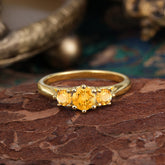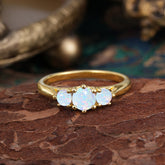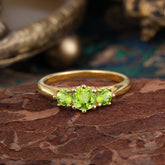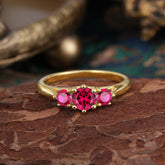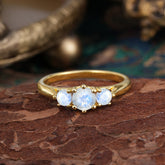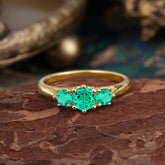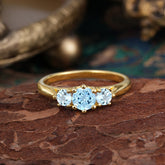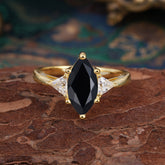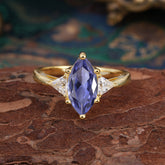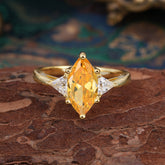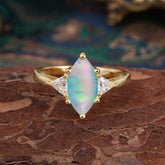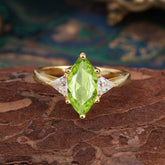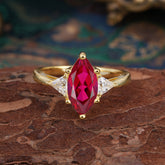Filter
134 results
20
- 10
- 15
- 20
- 25
- 30
- 50
Best selling
- Featured
- Best selling
- Alphabetically, A-Z
- Alphabetically, Z-A
- Price, low to high
- Price, high to low
- Date, old to new
- Date, new to old
Sort
Sort by:
- Featured
- Best selling
- Alphabetically, A-Z
- Alphabetically, Z-A
- Price, low to high
- Price, high to low
- Date, old to new
- Date, new to old
-
Round Cut 6 Prong Black Onyx Engagement Ring Classic Three Stone Bridal Ring - Yellow-GoldSpecifications Primary Stone Side Stones Stone Color: Black Stone Color: DEF Stone Material: Black Onyx Stone Material: Moissanite Lab Grown lab Grown Stone Shape: Round Stone Shape: Round Stone Size: 5mm Stone Clarity: VS Stone Ct: 0.5 Stone Ct: 0.04 Number Of Stones: 1...
- $249.18 USD
$311.48 USD- $249.18 USD
- Unit price
- / per
-
Yellow-Gold
-
Rose-Gold
-
White-Gold
-
Round Cut 6 Prong Black Rutilated Quartz Engagement Ring Classic Three Stone Bridal Ring - Yellow-GoldSpecifications Primary Stone Side Stones Stone Color: Black Stone Color: DEF Stone Material: Black Rutilated Quartz Stone Material: Moissanite Lab Grown lab Grown Stone Shape: Round Stone Shape: Round Stone Size: 5mm Stone Clarity: VS Stone Ct: 0.5 Stone Ct: 0.04 Number Of Stones:...
- $325.69 USD
$407.11 USD- $325.69 USD
- Unit price
- / per
-
Yellow-Gold
-
Rose-Gold
-
White-Gold
-
Round Cut 6 Prong Tanzanite Engagement Ring Classic Three Stone Bridal Ring - Yellow-GoldSpecifications Primary Stone Side Stones Stone Color: BLue Stone Color: DEF Stone Material: Tanzanite Stone Material: Moissanite Lab Grown lab Grown Stone Shape: Round Stone Shape: Round Stone Size: 5mm Stone Clarity: VS Stone Ct: 0.5 Stone Ct: 0.04 Number Of Stones: 1 Number...
- $325.69 USD
$407.11 USD- $325.69 USD
- Unit price
- / per
-
Yellow-Gold
-
Rose-Gold
-
White-Gold
-
Round Cut 6 Prong Citrine Engagement Ring Classic Three Stone Bridal Ring - Yellow-GoldSpecifications Primary Stone Side Stones Stone Color: Orange Yellow Stone Color: DEF Stone Material: Citrine Stone Material: Moissanite Lab Grown lab Grown Stone Shape: Round Stone Shape: Round Stone Size: 5mm Stone Clarity: VS Stone Ct: 0.5 Stone Ct: 0.04 Number Of Stones: 1...
- $256.97 USD
$321.21 USD- $256.97 USD
- Unit price
- / per
-
Yellow-Gold
-
Rose-Gold
-
White-Gold
-
Round Cut 6 Prong Opal Engagement Ring Classic Three Stone Bridal Ring - Yellow-GoldSpecifications Primary Stone Side Stones Stone Color: White Stone Color: DEF Stone Material: Opal Stone Material: Moissanite Lab Grown lab Grown Stone Shape: Round Stone Shape: Round Stone Size: 5mm Stone Clarity: VS Stone Ct: 0.5 Stone Ct: 0.04 Number Of Stones: 1 Number...
- $264.54 USD
$330.68 USD- $264.54 USD
- Unit price
- / per
-
Yellow-Gold
-
Rose-Gold
-
White-Gold
-
Round Cut 6 Prong Peridot Engagement Ring Classic Three Stone Bridal Ring - Yellow-GoldSpecifications Primary Stone Side Stones Stone Color: Green Stone Color: DEF Stone Material: Peridot Stone Material: Moissanite Lab Grown lab Grown Stone Shape: Round Stone Shape: Round Stone Size: 5mm Stone Clarity: VS Stone Ct: 0.5 Stone Ct: 0.04 Number Of Stones: 1 Number...
- $288.14 USD
$360.18 USD- $288.14 USD
- Unit price
- / per
-
Yellow-Gold
-
Rose-Gold
-
White-Gold
-
Round Cut 6 Prong Ruby Engagement Ring Classic Three Stone Bridal Ring - Yellow-GoldSpecifications Primary Stone Side Stones Stone Color: Red Stone Color: DEF Stone Material: Ruby Stone Material: Moissanite Lab Grown lab Grown Stone Shape: Round Stone Shape: Round Stone Size: 5mm Stone Clarity: VS Stone Ct: 0.5 Stone Ct: 0.04 Number Of Stones: 1 Number...
- $269.02 USD
$336.28 USD- $269.02 USD
- Unit price
- / per
-
Yellow-Gold
-
Rose-Gold
-
White-Gold
-
Round Cut 6 Prong Moonstone Engagement Ring Classic Three Stone Bridal Ring - Yellow-GoldSpecifications Primary Stone Side Stones Stone Color: Milk white Stone Color: DEF Stone Material: Moonstone Stone Material: Moissanite Lab Grown lab Grown Stone Shape: Round Stone Shape: Round Stone Size: 5mm Stone Clarity: VS Stone Ct: 0.5 Stone Ct: 0.04 Number Of Stones: 1...
- $366.07 USD
$457.59 USD- $366.07 USD
- Unit price
- / per
-
Yellow-Gold
-
Rose-Gold
-
White-Gold
-
Round Cut 6 Prong Emerald Engagement Ring Classic Three Stone Bridal Ring - Yellow-GoldSpecifications Primary Stone Side Stones Stone Color: Green Stone Color: DEF Stone Material: Emerald Stone Material: Moissanite Lab Grown lab Grown Stone Shape: Round Stone Shape: Round Stone Size: 5mm Stone Clarity: VS Stone Ct: 0.5 Stone Ct: 0.04 Number Of Stones: 1 Number...
- $300.89 USD
$376.11 USD- $300.89 USD
- Unit price
- / per
-
Yellow-Gold
-
Rose-Gold
-
White-Gold
-
Round Cut 6 Prong Aquamarine Engagement Ring Classic Three Stone Bridal Ring - Yellow-GoldSpecifications Primary Stone Side Stones Stone Color: Blue Stone Color: DEF Stone Material: Aquamarine Stone Material: Moissanite Lab Grown lab Grown Stone Shape: Round Stone Shape: Round Stone Size: 5mm Stone Clarity: VS Stone Ct: 0.5 Stone Ct: 0.04 Number Of Stones: 1 Number...
- $300.89 USD
$376.11 USD- $300.89 USD
- Unit price
- / per
-
Yellow-Gold
-
Rose-Gold
-
White-Gold
-
Round Cut 6 Prong Amethyst Engagement Ring Classic Three Stone Bridal Ring - Yellow-GoldSpecifications Primary Stone Side Stones Stone Color: Purple Stone Color: DEF Stone Material: Amethyst Stone Material: Moissanite Lab Grown lab Grown Stone Shape: Round Stone Shape: Round Stone Size: 5mm Stone Clarity: VS Stone Ct: 0.5 Stone Ct: 0.04 Number Of Stones: 1 Number...
- $265.47 USD
$331.84 USD- $265.47 USD
- Unit price
- / per
-
Yellow-Gold
-
Rose-Gold
-
White-Gold
-
Round Cut 6 Prong Garnet Engagement Ring Classic Three Stone Bridal Ring - Yellow-GoldSpecifications Primary Stone Side Stones Stone Color: Red Stone Color: DEF Stone Material: Garnet Stone Material: Moissanite Lab Grown lab Grown Stone Shape: Round Stone Shape: Round Stone Size: 5mm Stone Clarity: VS Stone Ct: 0.5 Stone Ct: 0.04 Number Of Stones: 1 Number...
- $265.47 USD
$331.84 USD- $265.47 USD
- Unit price
- / per
-
Yellow-Gold
-
Rose-Gold
-
White-Gold
-
6 Prong Marquise Cut Three Stone Black Onyx Engagement Ring Anniversary Gift for Women - Yellow-GoldSpecifications Primary Stone Side Stones Stone Color: Black Stone Color: DEF Stone Material: Black Onyx Stone Material: Moissanite Lab Grown lab Grown Stone Shape: Marquise Stone Shape: Trilliant Stone Size: 6*12mm Stone Clarity: VS Stone Ct: 2 Stone Ct: 0.08 Number Of Stones: 1...
- $346.71 USD
$433.39 USD- $346.71 USD
- Unit price
- / per
-
Yellow-Gold
-
Rose-Gold
-
White-Gold
-
6 Prong Marquise Cut Three Stone Black Rutilated Quartz Engagement Ring Anniversary Gift for Women - Yellow-GoldSpecifications Primary Stone Side Stones Stone Color: Black Stone Color: DEF Stone Material: Black Rutilated Quartz Stone Material: Moissanite Lab Grown lab Grown Stone Shape: Marquise Stone Shape: Trilliant Stone Size: 6*12mm Stone Clarity: VS Stone Ct: 2 Stone Ct: 0.08 Number Of Stones:...
- $349.54 USD
$436.93 USD- $349.54 USD
- Unit price
- / per
-
Yellow-Gold
-
Rose-Gold
-
White-Gold
-
6 Prong Marquise Cut Three Stone Tanzanite Engagement Ring Anniversary Gift for Women - Yellow-GoldSpecifications Primary Stone Side Stones Stone Color: BLue Stone Color: DEF Stone Material: Tanzanite Stone Material: Moissanite Lab Grown lab Grown Stone Shape: Marquise Stone Shape: Trilliant Stone Size: 6*12mm Stone Clarity: VS Stone Ct: 2 Stone Ct: 0.08 Number Of Stones: 1 Number...
- $343.17 USD
$428.96 USD- $343.17 USD
- Unit price
- / per
-
Yellow-Gold
-
Rose-Gold
-
White-Gold
-
6 Prong Marquise Cut Three Stone Citrine Engagement Ring Anniversary Gift for Women - Yellow-GoldSpecifications Primary Stone Side Stones Stone Color: Orange Yellow Stone Color: DEF Stone Material: Citrine Stone Material: Moissanite Lab Grown lab Grown Stone Shape: Marquise Stone Shape: Trilliant Stone Size: 6*12mm Stone Clarity: VS Stone Ct: 2 Stone Ct: 0.08 Number Of Stones: 1...
- $328.29 USD
$410.36 USD- $328.29 USD
- Unit price
- / per
-
Yellow-Gold
-
Rose-Gold
-
White-Gold
-
6 Prong Marquise Cut Three Stone Opal Engagement Ring Anniversary Gift for Women - Yellow-GoldSpecifications Primary Stone Side Stones Stone Color: White Stone Color: DEF Stone Material: Opal Stone Material: Moissanite Lab Grown lab Grown Stone Shape: Marquise Stone Shape: Trilliant Stone Size: 6*12mm Stone Clarity: VS Stone Ct: 2 Stone Ct: 0.08 Number Of Stones: 1 Number...
- $427.35 USD
$534.19 USD- $427.35 USD
- Unit price
- / per
-
Yellow-Gold
-
Rose-Gold
-
White-Gold
-
6 Prong Marquise Cut Three Stone Peridot Engagement Ring Anniversary Gift for Women - Yellow-GoldSpecifications Primary Stone Side Stones Stone Color: Green Stone Color: DEF Stone Material: Peridot Stone Material: Moissanite Lab Grown lab Grown Stone Shape: Marquise Stone Shape: Trilliant Stone Size: 6*12mm Stone Clarity: VS Stone Ct: 2 Stone Ct: 0.08 Number Of Stones: 1 Number...
- $465.01 USD
$581.26 USD- $465.01 USD
- Unit price
- / per
-
Yellow-Gold
-
Rose-Gold
-
White-Gold
-
6 Prong Marquise Cut Three Stone Ruby Engagement Ring Anniversary Gift for Women - Yellow-GoldSpecifications Primary Stone Side Stones Stone Color: Red Stone Color: DEF Stone Material: Ruby Stone Material: Moissanite Lab Grown lab Grown Stone Shape: Marquise Stone Shape: Trilliant Stone Size: 6*12mm Stone Clarity: VS Stone Ct: 2 Stone Ct: 0.08 Number Of Stones: 1 Number...
- $343.17 USD
$428.96 USD- $343.17 USD
- Unit price
- / per
-
Yellow-Gold
-
Rose-Gold
-
White-Gold
-
6 Prong Marquise Cut Three Stone Moonstone Engagement Ring Anniversary Gift for Women - Yellow-GoldSpecifications Primary Stone Side Stones Stone Color: Milk white Stone Color: DEF Stone Material: Moonstone Stone Material: Moissanite Lab Grown lab Grown Stone Shape: Marquise Stone Shape: Trilliant Stone Size: 6*12mm Stone Clarity: VS Stone Ct: 2 Stone Ct: 0.08 Number Of Stones: 1...
- $1,227.63 USD
$1,534.54 USD- $1,227.63 USD
- Unit price
- / per
-
Yellow-Gold
-
Rose-Gold
-
White-Gold











